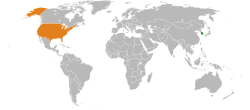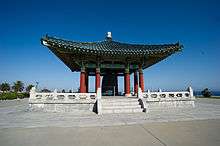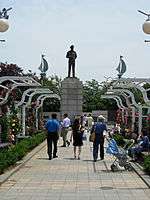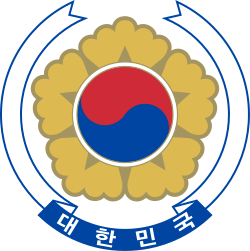South Korea–United States relations
 | |
South Korea |
United States |
|---|---|
| Diplomatic Mission | |
| South Korean Embassy, Washington D.C. | United States Embassy, Seoul |
| Envoy | |
| Ambassador Ahn Ho-Young | Ambassador Harry B. Harris Jr. |
South Korea–United States relations (Hangul: 한미 관계; Hanja: 韓美 關係; RR: Hanmi gwangye; MR: Hanmi kwan'gye) have been extensive since 1950, when the United States helped establish the modern state of South Korea, also known as the Republic of Korea, and fought on its UN-sponsored side in the Korean War (1950–1953). During the subsequent four decades, South Korea experienced tremendous economic, political and military growth, and significantly reduced U.S. dependency. From Roh Tae-woo's administration to Roh Moo-hyun's administration, South Korea sought to establish an American partnership, which has made the Seoul–Washington relationship subject to some strains, especially with the Anti-US/Korean sentiments. However, relations between the United States and South Korea have greatly strengthened under the conservative, pro-U.S. Lee Myung-bak administration. At the 2009 G20 London summit, U.S. President Barack Obama called South Korea "one of America's closest allies and greatest friends."[1] In addition, South Korea has been designated as a Major non-NATO ally.[2]
Currently, there are four factors largely shaping this alliance; 1) challenges posed by North Korea (or the overcoming of the challenges) especially regarding North Korea’s possession of weapon of mass destruction and its potential usage, 2) China’s rising influence in Northeast Asia which has become more and more impactful in different areas of U.S. – South Korea alliance, 3) South Korea’s transformation into one of the largest leading economies (with a strong export-base), and 4) South Korean leaders’ advantage of using their middle-power state to play a global role.[3] (International Relations of Asia 306 – 311pp)
According to a 2014 BBC World Service Poll, 58% of South Koreans view the United States' influence positively, while 28% view it negatively; 55% of Americans view South Korea's influence positively, while 34% view it negatively. South Korea is one of the most pro-American nations in the world.
The new US Ambassador to South Korea arrived in Seoul on July 7, 2018. The post had been vacant since President Donald Trump took office in January 2017. Harry Harris, a former head of the US military's Pacific Command, has expressed his resolve to work as an ambassador to strengthen the alliance between the United States and South Korea.[4]
.jpg)
Country comparison
Leaders of South Korea and the United States from 1950

Historical background
Korean War (6.25 War)
Cross-border skirmishes and raids at the 38th Parallel escalated into open warfare when the North Korean forces invaded South Korea on June 25, 1950.[6] The Korean War broke out when North Korea invaded South Korea. In response, 16 member countries of the United Nations, including the United States, came to the defense of South Korea. It was the first significant armed conflict of the Cold War with extensive deployment of American and other troops.[7]
Los Angeles Times, June 25, 2010
Origins of the South Korea–United States alliance
Following the end of World War II, the United States established a bilateral alliance with South Korea instead of establishing a multilateral alliance with South Korea and other East Asian countries.
Moreover, the "U.S. alliance with South Korea would consequently have three functions. First, it would serve as part of a network of alliances and military installations designed to ring the Soviet threat in the Pacific. Second, it would deter a second North Korean attack, with U.S. ground troops serving as the "tripwire" guaranteeing U.S. involvement. Third, it would restrain the South from engaging in adventurism."[9]
Military alliance

South Korea and the United States agreed to a military alliance in 1953.[10] They called it "the relationship forged in blood".[11] In addition, roughly 29,000 United States Forces Korea troops are stationed in South Korea. In 2009, South Korea and the United States pledged to develop the alliance’s vision for future defense cooperation.[12] Currently South Korean forces would fall under United States control should the war resume. This war time control is planned to revert to South Korea in 2020.[13]
At the request of the United States, President Park Chung-hee sent troops to Vietnam to assist American troops during the Vietnam War, maintaining the second largest contingent of foreign troops after the United States. In exchange, the United States increased military and economic assistance to South Korea. President Roh Moo-hyun, despite having been elected on a liberal platform, also authorized dispatching a small contingent of troops to Iraq in 2004 at the request of President George W. Bush.
The U.S. Government (June 16, 2009)
Since 2009 air forces of South Korea and the U.S.A. have conducted the annual joint exersices named "Max Thunder". In 2018 the drills began on May 11 and continued until May 17.[15]
At a Cabinet meeting in Seoul on 10 July 2018 the government has decided not to hold this year's Ulchi drill scheduled for next month. Government said the decision was made in line with recent political and security improvements on the peninsula and the suspension of South Korea-U.S. joint military exercises.[16]
There were six round of talks according to the defense costs. Last ones are held 22-23 August. The latest negotiations come as Washington wants Seoul to shoulder a greater burden, including costs for "operational support" of deploying strategic assets from outside the peninsula to counter North Korean military threats. Under the current five-year contract which will expire in December, Seoul's cost-sharing for stationing the 28-thousand-500-member U.S. Forces Korea for this year is set at around 960 billion won or 856 million dollars.[17]
One of the key reasons behind the formation of the two nations’ alliance is the deterrence of North Korea and the issue of de-nuclearization of the country. In 2018, summits between the three countries have happened more frequently than in the past decade altogether. It seems the Trump Administration’s prioritized approaching North Korea one of the prioritized U.S. foreign policy. With the change of administrations in both the United States and South Korea in 2016 and 2017 respectively, today both approach North Korea in a peaceful manner.
The current South Korean President Moon Jae-in, elected in May 2017, has said he supports the continuation of sanctions against North Korea if it is aimed at bringing North Korea out of its “hermit” to the negotiating table. He also argued, at the same time, that he was against a “sanctions-only” approach toward North Korea.[18] His approach to North Korea is similar to Kim Dae-jung’s Sunshine Policy, which only continued up to the Roh Mu-hyun’s administration.
The United States and South Korea are allies under the 1953 Mutual Defense Treaty. Under the agreement, U.S. military personnel have maintained a continuous presence on the Korean peninsula and are committed to helping Korea defend itself, particularly against any type of aggression from the North. South Korea is included under the U.S. nuclear umbrella.
After the North Korean satellite launch in February 2016, US and ROK officials made a joint statement that the allies would examine the deployment of T.H.A.A.D (Terminal High Altitude Area Defense) to South Korea, prompting harsh reactions from China and Russia. China complained that the THADD system could be configured to allow US to monitor airspace deep into the Chinese territory. The Chinese ambassador had repeatedly warned before to Seoul that the China-ROK relationship could be destroyed if the US places T.H.A.A.D. in South Korea. However, South Korean officials have stood against China’s threats and established T.H.A.A.D. on the Korean Peninsula.[19]
Issues

Since the end of the Korean War, South Korea and the United States have maintained strong ties.
Opinion polling
According to Pew Research Center, 84% of South Koreans have a favorable view towards the United States and Americans (ranked within top 4 among the countries in the world).[20][21] Also, according to a Korean Gallup poll, South Korea views the U.S. as the most favorable country in the world.[22] In the political side, the United States supported South Korea after 1945 as a "staunch bastion against communism", even when it was ruled by a dictatorship.[23] In a March 2011 Gallup Poll, 74% of South Koreans said that they believe that the U.S. influence in the world is favorable,[24] and in a November 2011 Gallup Poll, 57% of South Koreans approved of U.S. leadership, with 22% disapproving; by contrast, only 30% of South Koreans approved of China's leadership.[25]
Americans are steadily viewing South Korea more positively as well, with the 2011 Gallup poll – a 65% favorability rating – being the highest rating to date.[24] Thus, the relationship between the two countries, as indicated by polling results, is steadily improving.
According to a 2014 BBC World Service Poll, 58% of South Koreans view U.S. influence positively, the highest rating for any surveyed Asian country.[26]
Environmental degradation
On February 9, 2000, the Eighth U.S. Army ordered twenty boxes of formaldehyde, a toxic fluid, dumped into the Han River. South Korean environmentalist groups protested that it could be harmful to aquatic life forms, but the U.S. military insisted that it was diluted with water. This incident was satirized in the 2006 South Korean monster film The Host, where a horrible mutated monster from the river menaces the inhabitants of Seoul.[27]
Beef controversy
The Government of South Korea banned imports of U.S. beef in 2003 in response to a case of mad cow disease in Washington state. In 2008, the protests against U.S. beef recalled the student "pro-democracy" movements of the 1980s. Nevertheless, South Korea became the world's third largest U.S. beef importer in 2010. With its strong import growth, South Korea surpassed Japan for the first time to become the largest market for U.S. beef in Asia and in 2016 US beef imports in Korea reached a value of $1 billion.[28][29]
Economic relations
As South Korea underwent rapid economic growth that boosted the small nation into one of the largest industrialized countries, South Korea has been one of U.S.’s largest trading partners. The democratization movements in the 1980s and the “econophoria” of the country helped raise South Korea into a middle regional power that holds the potential to influence U.S. policy in NE Asia, especially towards the United State's. approach to North Korea.[30]
South Korea and the United States are important economic partners to each other. Nearly 60 billion dollars of trade volume between the two countries display the significant economic interdependence between the two states. However, according to the CRS report, South Korea is much more economically reliant on the United States than the United States is on South Korea. This is supported with the fact that the United States ranks first as a trading partner for South Korea.[31] However, a recent policy brief introduces the fact that the ratio of exports to the United States has declined significantly from around 40 percent to less than 20 percent in 2002 while the share of exports to China has increased drastically which led China to become the number one export destination for South Korea.[32] Although the economy of South Korea and the United States is becoming more integrated with the recent ratification of the KORUS Free Trade Agreement, there remains some major trade disputes between the two nations in the areas including telecommunications, automotive industry, intellectual property rights issues, pharmaceutical industry, and agricultural industry especially in terms of rice and beef.[31]
South Korea’s export-driven economy and competition with domestic U.S. producers in certain fields of products have led to some trade friction with the United States. For example, imports of certain steel and non-steel products have been subject to U.S. anti-dumping and countervailing duty investigations – a total of 29 U.S. imports from South Korea have been assessed. [33]
See also
References
- ↑ President Obama Vows Strengthened U.S.-South Korea Ties Archived 2009-07-04 at the Wayback Machine. 2 Apr 2009. Embassy of the United States, Seoul
- ↑ Farberov, Snejana (6 July 2012). "Hillary Clinton flies into Kabul as U.S. declares Afghanistan major non-NATO ally". Daily Mail. Retrieved May 28, 2015.
Afghanistan becomes the 15th such country the U.S. has declared a major non-NATO ally. The list includes Argentina, Australia, Bahrain, Egypt, Israel, Japan, Jordan, Kuwait, Morocco, New Zealand, the Philippines, South Korea and Thailand.
- ↑ Shambaugh, Yahuda, David, Michael (2014). International Relations of Asia. Lanham, Maryland: Rowman & Littlefield. pp. 306–311. ISBN 978-1- 4422- 2640- 1.
- ↑ {{https://www3.nhk.or.jp/nhkworld/en/news/20180708_05/}}
- ↑ Jayu Park Archived 2011-01-14 at the Wayback Machine. lifeinkorea.com
- ↑ Devine, Robert A.; Breen, T. H.; Frederickson, George M.; Williams, R. Hal; Gross, Adriela J.; Brands, H.W. (2007). America Past and Present 8th Ed. Volume II: Since 1865. Pearson Longman. pp. 819–821. ISBN 0-321-44661-5.
- ↑ Hermes, Jr., Walter (1992) [1966]. Truce Tent and Fighting Front. United States Army Center of Military History. pp. 2, 6–9. CMH Pub 20-3-1.
- ↑ From South Korea, a note of thanks June 25, 2010. Los Angeles Times
- ↑ Cha, Victor (Winter 2009–2010). Powerplay: Origins of U.S. Alliances in Asia. p. 174.
|access-date=requires|url=(help) - ↑ The ROK-US Mutual Defense Treaty Archived 2011-01-22 at the Wayback Machine. Embassy of the Republic of Korea in the United States
- ↑ Speeches of U.S. Ambassador, March 20, 2009 Archived May 28, 2010, at the Wayback Machine.
… One of the first phrases I learned in Korean, I heard in Korean, when people talked about the US-Korea relationship, was 혈맹관계, "the relationship forged in blood." I remember how moved I was by that, by the passion which people used in talking about it. Our relationship, as you all well know, goes further back even than that …
(March 20, 2009, U.S. Ambassador in the Republic of Korea) - ↑ Joint Statement of ROK-US Foreign and Defense Ministers’ Meeting 07-21-2010. The Korea Times
- ↑ "US, South Korea agree to again delay handover of wartime operational control to Seoul."
- ↑ Joint vision for the Alliance of the Republic of Korea and the United States of America Archived 2011-01-23 at the Wayback Machine. June 16, 2009. The White House
- ↑ https://www.bbc.com/news/av/world-asia-39656840/us-and-south-korea-carry-out-max-thunder-military-drill
- ↑ {{http://world.kbs.co.kr/english/news/news_Po_detail.htm?No=137694&id=Po}}
- ↑ {{http://world.kbs.co.kr/service/news_view.htm?lang=e&Seq_Code=138769}}
- ↑ "US and South Korea agree to 'stronger' sanctions against North Korea". Deutsche Welle. September 17, 2017. Retrieved September 30, 2018.
- ↑ "[단독] 시진핑에 실망한 대통령 "中역할 기대 말라"" (in Korean). Retrieved 2018-10-01.
- ↑ Opinion of the United States Pew Research Center
- ↑ South Koreans remain strongly pro-American Pew Research Center
- ↑ "한국에 긍정적 영향을 미친 국가는 미국 " 80.7% (80.7% Korean think US gave most positive influence to Korea)(in Korean)
- ↑ Stockwell, Eugene (1976-05-01). "South Korea's leader Communism's best ally?". The Gadsden Times. Retrieved 2010-04-10.
- 1 2 "Archived copy" (PDF). Archived from the original (PDF) on 2012-11-23. Retrieved 2013-03-03.
- ↑ U.S. Leadership Approval Ratings Top China's in Asia Gallup (company)
- ↑ 2014 World Service Poll BBC
- ↑ Jon Herskovitz (2006-09-07). "South Korean movie monster gobbles up box office". Reuters. Retrieved 2006-11-02.
- ↑ S. Korea becomes world's third largest U.S. beef importer July 16, 2010. People's Daily
- ↑ US Meat Export Federation. "U.S. beef exports to Korea reach new heights; poised for further growth in 2017". Beef Magazine. Beef Magazine. Retrieved 8 November 2017.
- ↑ Howe, Brendan (June 2016). "East Asian 'Econophoria' in Theory and Practice". Asian International Studies Review. 17 No.1: 101–120.
- 1 2 Manyin, M. (2004). South Korea-U.S. Economic Relations: Cooperation, Friction, and Future Prospects. CRS Report for Congress. Retrieved from https://fpc.state.gov/documents/organization/34347.pdf
- ↑ Noland, M. (2003). The Strategic Importance of US-Korea Economic Relations. International Economics Policy Briefs. Retrieved from http://www.iie.com/publications/pb/pb03-6.pdf
- ↑ Editorial, Reuters. "South Korea to take dispute on U.S. steel anti-dumping duties to WTO". U.S. Retrieved 2018-10-01.
Further reading
- Baldwin, Frank, ed. Without Parallel: The American-Korean Relationship since 1945 (1973).
- Berger, Carl. The Korean Knot: A Military-Political History (U of Pennsylvania Press, 1964).
- Chay, Jongsuk. Diplomacy of Asymmetry: Korea-American Relations to 1910 (U of Hawaii Press, 1990).
- Chung, Jae Ho. Between Ally and Partner: Korea-China Relations and the United States (2008) excerpt and text search
- Cumings, Bruce. The Origins of the Korean War: Liberation and the Emergence of Separate Regimes, 1945-1947 (Princeton UP, 1981).
- Cumings, Bruce. ed. Child of Conflict: The Korean-American Relationship, 1943-1953 (U of Washington Press, 1983).
- Dennett, Tyler. "Early American Policy in Korea, 1883-7." Political Science Quarterly 38.1 (1923): 82-103. in JSTOR
- Denett, Tyler. Americans in East Asia: A Critical Study of the Policy of the United States with References to China, Japan, and Korea in the Nineteenth Century. (1922) online free
- Harrington, Fred Harvey. God, Mammon, and the Japanese: Dr. Horace N. Allen and Korean- American Relations, 1884-1905. (U of Wisconsin Press, 1944).
- Hong, Hyun Woong. "American Foreign Policy Toward Korea, 1945-1950" (PhD dissertation, Oklahoma State University, 2007) online bibliography pp 256–72.
- Kim, Byung-Kook; Vogel, Ezra F. The Park Chung Hee Era: The Transformation of South Korea (Harvard UP, 2011).
- Kim, Seung-young, ed. American Diplomacy and Strategy toward Korea and Northeast Asia, 1882 - 1950 and After (2009) online
- Lee, Yur-Bok and Wayne Patterson. One Hundred Years of Korean-American Relations, 1882-1982 (1986) online
- Ryu, Dae Young. "An Odd Relationship: The State Department, Its Representatives, and American Protestant Missionaries in Korea, 1882—1905." Journal of American-East Asian Relations 6.4 (1997): 261-287.
- Yuh, Leighanne. "The Historiography of Korea in the United States". International Journal of Korean History (2010). 15#2: 127–144.

